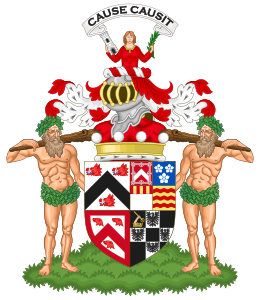Clan Elphinstone facts for kids
Quick facts for kids Clan Elphinstone |
|||
|---|---|---|---|

Crest: A lady, from the waist upwards, richly habited in red, her arms extended, the right hand supporting a tower and the left holding a branch of laurel, all Proper.
|
|||
| Motto | Cause causit | ||
| Profile | |||
| Region | Lowlands | ||
| District | East Lothian | ||
| Chief | |||
 |
|||
| The Right Hon. Alexander Elphinstone | |||
| 19th Lord Elphinstone | |||
| Seat | Whitberry House, Tyninghame, East Lothian | ||
| Historic seat | Elphinstone Tower, Stirlingshire | ||
|
|||
|
|||
Clan Elphinstone is a historic Lowland Scottish clan. A clan is a group of families linked by a common ancestor and a shared surname. The Elphinstone clan has a long and interesting history in Scotland.
Contents
History of Clan Elphinstone
Where the Elphinstone Name Comes From
The Elphinstone name first appeared around 1235 in East Lothian, Scotland. It was mentioned in a document by Alanus de Swinton. It's thought that John, Alanus de Swinton's son, later became known as John de Elfinstun.
One idea is that the family name came from the 'de Erth' family. They lived near Airth in Stirlingshire. When a woman from this family married, her husband's lands near Tranent in East Lothian might have been named after her family.
Another story says the family came from Flemish knights. These knights were called Helphenstein. Some people also think the name comes from Alpin's tun. This means "Alpin's farmstead."
Important People in the 14th, 15th, and 16th Centuries
Sir John de Elfinstun married Margaret of Seton. She was a niece of the famous Scottish king, Robert the Bruce.
One of John's family members was William Elfinstun. He became a church leader in Glasgow. William studied law in Paris and later became a professor there. He also became the Bishop of Aberdeen in 1484. He was even the Lord High Chancellor of Scotland. William helped start the University of Aberdeen in 1494.
A cousin of Bishop William was Sir Alexander Elphinstone. King James IV of Scotland made him a Lord. Alexander and the king both died at the Battle of Flodden in 1513.
Alexander's son, also named Alexander Elphinstone, was killed in battle too. This happened at the Battle of Pinkie in 1547.
Later, in 1599, the fourth Lord Elphinstone became a judge. He served on Scotland's highest court.
The 18th Century and Jacobite Risings
A part of the Elphinstone family were the Lords Balmerino. They strongly supported the Jacobites. The Jacobites wanted to bring the Stuart kings back to the throne.
The sixth Lord Balmerino was captured after the Battle of Culloden. He lost his life in August 1746.
The eleventh Lord Elphinstone was the lieutenant governor of Edinburgh Castle. This was an important role in protecting the castle.
The 19th and 20th Centuries
One of the eleventh Lord's younger brothers was George Keith Elphinstone. He was a very skilled naval officer. He helped protect British ships off the coast of America. He was given the title of Baron Keith, and later Viscount in 1814.
The Viscount's nephew was William George Elphinstone. He was a colonel at the famous Battle of Waterloo in 1815. He later became a commander in the Bengal army in 1837. He led the Afghan campaign of 1841.
Clan Chief
The current leader of Clan Elphinstone is Alexander Lord Elphinstone. He became the chief in 1994 when he was 14 years old.
Clan Castles
The Clan Elphinstone has been linked to several castles over the centuries:
See also


